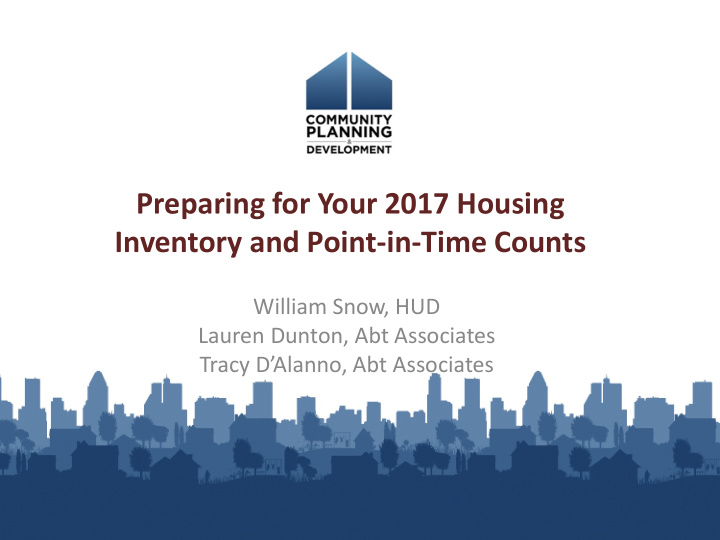



Preparing for Your 2017 Housing Inventory and Point-in-Time Counts William Snow, HUD Lauren Dunton, Abt Associates Tracy D’Alanno, Abt Associates
The HIC and the PIT Count The Housing Inventory Count (HIC) • A report that informs the homeless assistance community on the capacity to house persons who are homeless at local and national levels The Point-in-Time (PIT) Count • Provides the homeless assistance community with data needed to understand the number and characteristics of persons who are homeless at one point-in-time • CoCs are required to conduct a sheltered and an unsheltered count during the last ten days of January 2017 2
2017 HIC and PIT Count Notice Notice CPD-16-060: 2017 HIC and PIT Data Collection for CoC and ESG Programs All CoCs should review to understand all the information that must be collected the last ten days in January in order to successfully complete the HIC and PIT in 2017. 3
2017 PIT Count: Baseline Year for Homeless Youth 2017 will be the baseline year for PIT count data for tracking progress towards ending youth homelessness PIT count data will only be one of many important data sources for identifying homeless youth Identifying homeless youth in the PIT count has been a challenge and we have seen communities make great progress in the past few years Success is in building partnerships with key actors including schools, youth providers, and child welfare Several resources for identifying homeless youth will be made available from HUD, NAEH, VoYC, NN4Y, etc. 4
Housing Inventory Count (HIC) 5
What to Include in the HIC Only projects with beds and units dedicated to serving homeless persons, meaning: The primary intent of project is to serve homeless persons; The project verifies homeless status as part of its eligibility determination; The actual program clients are predominantly homeless. Beds and units in the HIC must be dedicated to serving homeless persons, or for permanent housing projects, dedicated for persons who were homeless at entry. 6
Changes to the HIC for 2017 1. The Rapid Rehousing Demonstration Program - DEM project type has been removed. 2. The McKinney-Vento funding question has been expanded from a “Yes” or “No” question to require CoCs to identify the actual HUD McKinney-Vento funding source associated with HMIS PDDE 2.6 – Federal Funding Source. 3. VA GPD (TIP) projects should report beds under the “Other Permanent Housing” (OPH) project type. Persons in these beds should not be included in the PIT Count. 7
Changes to the HIC for 2017 4. Beds dedicated for youth should include beds for all members of a youth headed household. 5. A new field “Housing Type” has been added that combines the Transitional Housing (TH) Unit Type field and the scattered site field from the address section of the HIC. In this field CoCs will indicate whether the project is: • Site-based – single site • Site-based – clustered / multiple sites • Tenant-based – scattered site 8
Point-In-Time Count (PIT ) 9
PIT Count Guidance CoCs are required to conduct PIT counts biennially during last 10 days in January. CoCs are required to conduct a sheltered and an unsheltered count in 2017. Counts must be conducted in compliance with HUD standards and PIT Count Methodology Guide CoCs will be required to identify in HDX the methodologies used for their 2017 PIT count CoCs are strongly encouraged to use HMIS to generate their sheltered count where possible 10
Sheltered PIT Count All persons who meet the criteria at 24 CFR 578.3 of the Homeless Definition Final Rule 11
Unsheltered PIT Count Include all persons who meet criteria at 24 CFR 578.3 of the Homeless Definition Final Rule 12
People to NOT Include in PIT Count • in PSH projects (including VASH) and RRHD projects • in locations not listed on the HIC (i.e., beds/units not dedicated for Do not include homeless) people residing: • temporarily with family or friends • in housing they rent or own (permanent housing), including rental housing with RRH assistance • People residing in institutions 13
Changes to PIT Count for 2017 New gender identity option – “Don’t identify as male, female, or transgender. The new gender category is intended to represent people whose gender identity is not “male, female, or transgender,” and should not be used in the event that gender of a person is unknown. CoCs should use approved extrapolation techniques to ensure that the total number of persons listed under each category equal the total number of persons counted. 14
Changes to PIT Count for 2017 Persons experiencing chronic homelessness will now be reported by Household Type. HUD clarification: If one adult or youth head of a household qualifies as chronically homeless, than all persons in the household should be counted as chronically homeless. This means that CoCs should count all persons in the household as chronically homeless and all beds on the HIC dedicated to these household members should be counted on the HIC. 15
PIT/HIC Count Tools, Guidance and Webinars PIT and HIC Resources 16
Questions Submit Questions to HUD’s Exchange’s Ask-a-Question at: https://www.hudexchange.info/program-support/ Please note: Due to the high volume of questions, please read the regulations and the training materials provided prior to submitting your question to Ask-a-Question 17
Recommend
More recommend